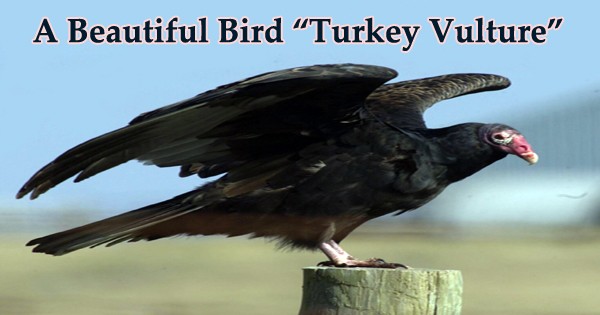A vulture is a big bird of prey with a mostly featherless head and neck. Vultures are also known as buzzards or condors in different parts of the world and depending on the species. The turkey vulture (Cathartes aura), also known as the turkey buzzard (or plain buzzard) in some parts of North America and as the John crow or carrion crow in other parts of the Caribbean, is the most common of the New World vultures. Most birds are thought to have a weak sense of smell, but the Turkey Vulture is an exception since it appears to be able to detect carrion by odor. The turkey vulture is one of three species in the Cathartes genus of the Cathartidae family, and it may be found from southern Canada to the southernmost tip of South America. It can be found in a wide range of open and semi-open environments, including as subtropical woods, shrublands, pastures, and deserts. Turkey vultures are connected to storks, not other birds of prey. In Latin, their scientific name means “cleansing breeze.” The turkey vulture, like all other vultures, has a bald head. This prevents fragments of carrion (dead flesh) from sticking to the skin like feathers would. The naked redheads of adult turkey vultures resemble those of turkeys when viewed up close, hence the name. The only scavenger birds that can’t kill their meal are these vultures. It is not closely linked to the Old-World vultures of Europe, Africa, and Asia, as are the New World vultures. Because of convergent evolution, the two groups are strikingly similar. Natural selection frequently results in identical body designs in animals that adapt to the same environments independently. Enormous dark birds with long, broad wings, Turkey Vultures are large black birds with long, broad wings. They have lengthy “fingers” at their wingtips and long tails that extend past their toe tips in flight, making them larger than any other raptors except eagles and condors. When soaring, Turkey Vultures elevate their wings slightly, forming a V when viewed from the front. From a distance, these vultures appear black, but up close, they are dark brown with a featherless red head and light bill. The undersides of the flight feathers (along the trailing edge and wingtips) are paler than the rest of their body and forewing, giving them a two-toned look. Vultures have comparatively bare heads and often bare necks so that germs and other parasites cannot burrow into dense feathers and infect them while they feed on rotting carcasses. This keeps the birds healthy while allowing them to eat debris that may readily infect other species. Their legs and feet are quite feeble, having blunt talons, but they have powerful bills. They will wait for another predator to open the flesh if the body is too stiff for them to rip open. Vultures frequently coexist with other carrion-eating animals including hyenas, coyotes, and eagles. A detailed examination of their feet reveals that they resemble a chicken rather than a hawk or an eagle. Turkey Vultures have powerful beaks that can tear through even the strongest cowhide, but their feet are ineffective for cutting into prey. They eat by shoving their heads into rotting animals’ bodily cavities.

The turkey vulture is a scavenger that eats almost entirely dead animals. It hunts for food with its strong eyes and great sense of smell, flying low enough to detect the gasses released by the start of the decay process in dead animals. Turkey Vultures are magnificent birds of prey, but they are shaky fliers. Their flying is characterized by a wobbling motion with minimal wingbeats. Look for them gliding low to the ground, sniffing for carrion, or riding thermals to higher altitudes. They soar in small groups and roost in big flocks. It’s a big bird with a wing span of 160–183 cm (63–72 in), a length of 62–81 cm (24–32 in), and a weight of 0.8–2.41 kg (1.8 to 5.3 lb). The vulture from the neotropics is larger on average than the birds at the northern end of the species’ range. 124 birds from Florida weighed an average of 2 kg (4.4 lb), while 65 and 130 birds from Venezuela weighed an average of 1.22 kg (2.7 and 3.2 lb). Roadsides, suburbs, farm fields, countryside, and food sources such as landfills, trash heaps, and construction sites are all typical places for Turkey Vultures to be seen. Look for them aloft as early as 9 a.m. on sunny days; they roost on poles, towers, dead trees, and fence posts in cooler weather and at night. Vultures like turkeys have a keen sense of smell. They have been observed to detect carrion from almost a mile away, which is extremely unusual for a bird. All birds have a large olfactory (smelling) system, but the turkey vulture has the most. Vultures prefer meat that is as fresh as possible and will not eat carcasses that are severely rotten. They can only smell carrion that has been dead for 12 to 24 hours. Turkey vultures can be seen sunning in a tree with their wings spread out in the early morning hours. This is done to raise their body temperature following a cold night. The body feathers are predominantly brownish-black, but the flight feathers on the wings have a silvery-gray underside, which contrasts with the darker wing linings. The head of an adult is small in comparison to its size, crimson in color, and has few or no feathers. It also has an ivory-colored beak that is short and hooked. The irises of the eyes are gray-brown, and the flesh of the legs and feet is pink, but it is usually discolored white. On the upper lid, there is a single incomplete row of eyelashes and two rows on the lower lid. Turkey vultures can travel up to 200 miles each day, according to researchers. Turkey vultures stand 2 1/2 feet tall and have a wingspan of 6 feet. They only weigh roughly 3 pounds despite their huge size. Like most other vultures, the turkey vulture has limited vocalization ability. It can only make hisses and grunts because it lacks a syrinx. When it feels threatened or is battling with other vultures over a cadaver, it hisses. Grunts are regularly heard from both hungry children and adults who are courting. Females usually lay two eggs, although they can also deposit one or three. Cream-colored eggs with brown or purple dots around the bigger end After 30 to 40 days of incubation by both parents, the young hatch. When it’s hot outside, turkey vultures will defecate on their feet to keep cool. Because vultures’ digestive secretions kill bacteria, which is why they don’t get sick from eating decaying meat, defecating on their legs could operate as an antiseptic wash. International Vulture Awareness Day, observed on the first Saturday of September each year, is dedicated to vultures. Every year, hundreds of zoos, aviaries, nature preserves, and bird refuges throughout the world host entertaining and educational programs about vultures to help everyone understand how fascinating and vital these birds are.
















